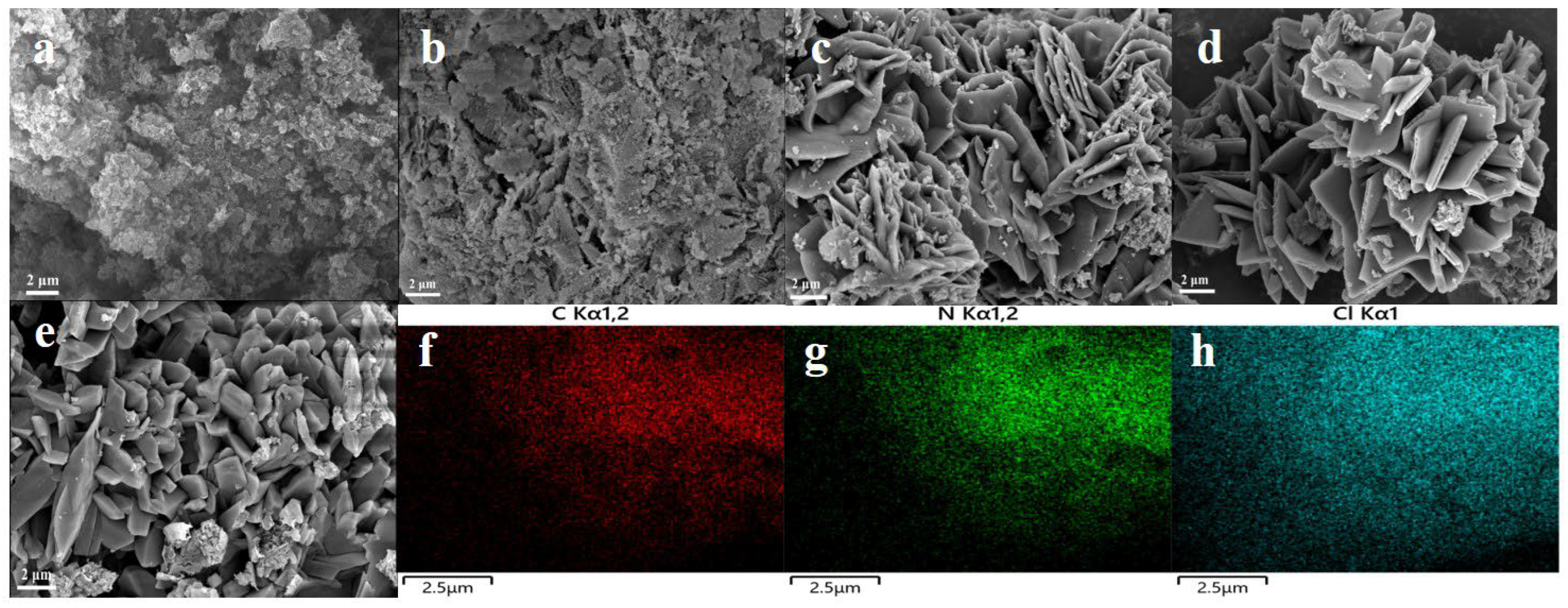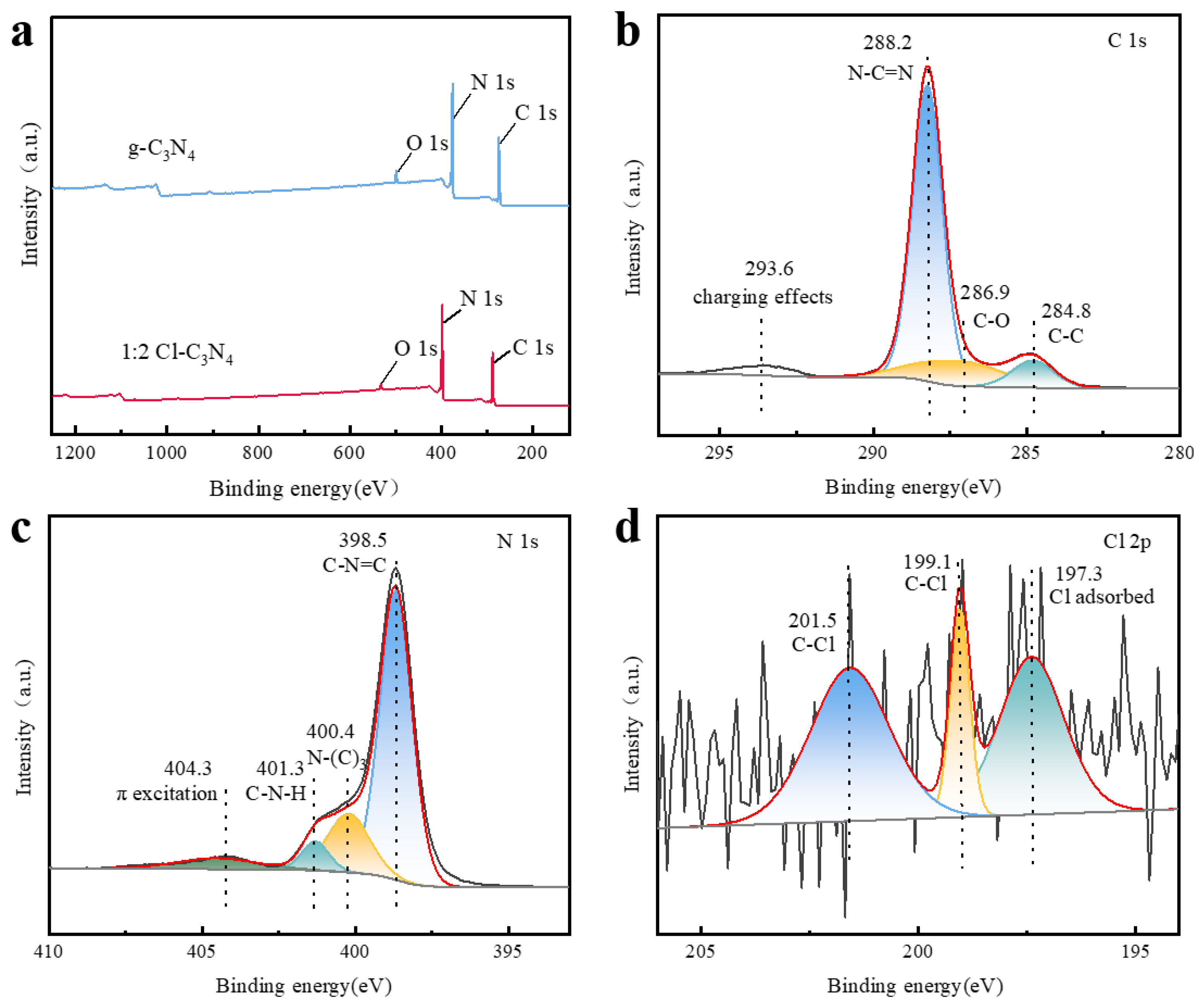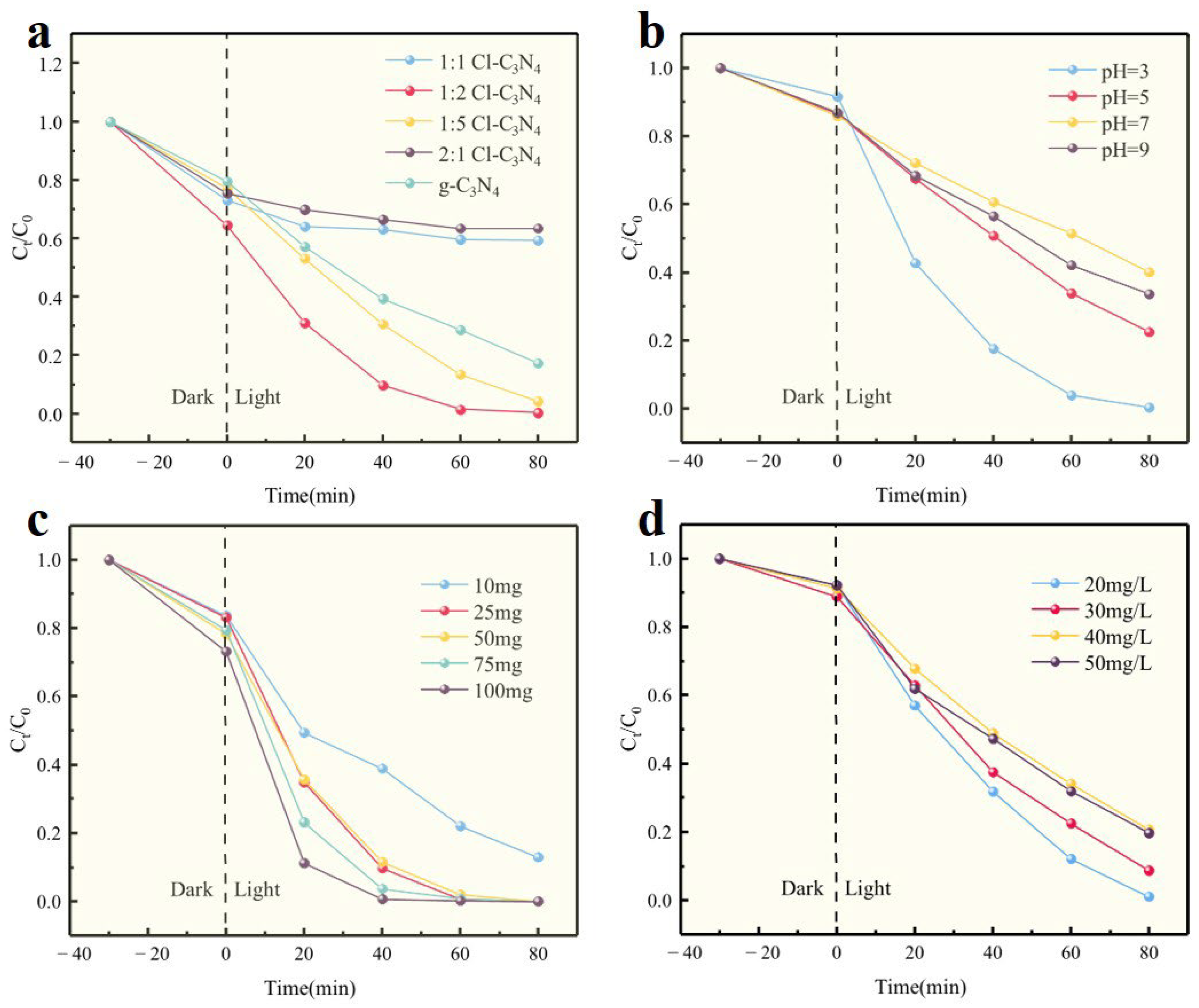Preparation of Cl-Doped g-C3N4 Photocatalyst and Its Photocatalytic Degradation of Rhodamine B
Abstract
1. Introduction
2. Results and Discussion
2.1. Catalyst Characterization
2.2. Effect of Different Factors on Catalytic Activity
2.2.1. Different Ratios of Catalysts
2.2.2. pH
2.2.3. Different Dosage
2.2.4. Initial RhB Concentration
2.3. TOC Testing and Cycling Stability of 1:2 Cl-C3N4
2.4. Degradation Mechanism
2.4.1. Radical Trapping and EPR Tests
2.4.2. Photodegradation Mechanism of 1:2 Cl-C3N4 Toward RhB
3. Experimental Section
3.1. Reagents and Instruments
3.1.1. Experimental Reagents
3.1.2. Experimental Equipment
3.2. Experimental Process
3.2.1. Preparation of Photocatalysts
Preparation of g-C3N4
Preparation of Cl-C3N4
3.2.2. Photocatalytic Experiment
3.2.3. Reactive Group Capture Probe
3.3. Testing and Characterization
4. Conclusions
Author Contributions
Funding
Institutional Review Board Statement
Informed Consent Statement
Data Availability Statement
Conflicts of Interest
References
- Díaz, S.; Settele, J.; Brondízio, E.S.; Ngo, H.T.; Agard, J.; Arneth, A.; Balvanera, P.; Brauman, K.A.; Butchart, S.H.M.; Chan, K.M.A.; et al. Pervasive human-driven decline of life on earth points to the need for transformative change. Science 2019, 366, eaax3100. [Google Scholar] [CrossRef] [PubMed]
- Saeed, M.; Ahmad, A.; Boddula, R.; Inamuddin; Haq, A.U.; Azhar, A. Ag@mnxoy: An effective catalyst for photo-degradation of Rhodamine B dye. Environ. Chem. Lett. 2018, 16, 287–294. [Google Scholar] [CrossRef]
- Skjolding, L.M.; Jørgensen, L.V.; Dyhr, K.S.; Köppl, C.J.; Mcknight, U.S.; Bauer-Gottwein, P.; Mayer, P.; Bjerg, P.L.; Baun, A. Assessing the aquatic toxicity and environmental safety of tracer compounds. Rhodamine B and Rhodamine wt. Water Res. 2021, 197, 117109. [Google Scholar] [CrossRef]
- Donkadokula, N.Y.; Kola, A.K.; Naz, I.; Saroj, D. A review on advanced physico-chemical and biological textile dye wastewater treatment techniques. Rev. Environ. Sci. Bio/Technol. 2020, 19, 543–560. [Google Scholar] [CrossRef]
- Poornima, S.; Manikandan, S.; Karthik, V.; Balachandar, R.; Subbaiya, R.; Saravanan, M.; Lan Chi, N.T.; Pugazhendhi, A. Emerging nanotechnology based advanced techniques for wastewater treatment. Chemosphere 2022, 303, 135050. [Google Scholar] [CrossRef]
- Yang, H.; Li, E.; Zhou, B.; Wang, Y.; Li, P.; Xia, S. Preparation and characterization of a g-C3N4/lsacf composite and application in rhb degradation. J. Inorg. Organomet. Polym. Mater. 2020, 30, 1463–1472. [Google Scholar] [CrossRef]
- Wang, M.; Li, C.; Liu, B.; Qin, W.; Xie, Y. Facile synthesis of nano-flower β-Bi2O3/TiO2 heterojunction as photocatalyst for degradation RhB. Molecules 2023, 28, 882. [Google Scholar] [CrossRef]
- Dayi, B.; Duishemambet Kyzy, A.; Akdogan, H.A. Characterization of recuperating talent of white-rot fungi cells to dye-contaminated soil/water. Chin. J. Chem. Eng. 2019, 27, 634–638. [Google Scholar] [CrossRef]
- Fan, G.; Ning, R.; Yan, Z.; Luo, J.; Du, B.; Zhan, J.; Liu, L.; Zhang, J. Double photoelectron-transfer mechanism in Ag-AgCl/WO3/g-C3N4 photocatalyst with enhanced visible-light photocatalytic activity for trimethoprim degradation. J. Hazard. Mater. 2021, 403, 123964. [Google Scholar] [CrossRef]
- Da Rosa, M.P.; Igansi, A.V.O.; L Tke, S.F.; Sant Anna Cadaval, T.R.; Do Santos, A.C.R.; de Oliveira Lopes Inacio, A.P.; de Almeida Pinto, L.A.; Beck, P.H. A new approach to convert rice husk waste in a quick and efficient adsorbent to remove cationic dye from water. J. Environ. Chem. Eng. 2019, 7, 103504. [Google Scholar] [CrossRef]
- Wang, J.; Guo, X. Adsorption isotherm models: Classification, physical meaning, application and solving method. Chemosphere 2020, 258, 127279. [Google Scholar] [CrossRef] [PubMed]
- Chen, Z.; Li, Z.; Chen, J.; Kallem, P.; Banat, F.; Qiu, H. Recent advances in selective separation technologies of rare earth elements: A review. J. Environ. Chem. Eng. 2022, 10, 107104. [Google Scholar] [CrossRef]
- Huang, L.; Li, H.; Li, Y. Greenhouse gas accounting methodologies for wastewater treatment plants: A review. J. Clean. Prod. 2024, 448, 141424. [Google Scholar] [CrossRef]
- Lei, J.; Zhou, N.; Sang, S.; Meng, S.; Low, J.; Li, Y. Unraveling the roles of atomically-dispersed au in boosting photocatalytic CO2 reduction and aryl alcohol oxidation. Chin. J. Catal. 2024, 65, 163–173. [Google Scholar] [CrossRef]
- Zhao, Y.; Zhang, X.; Wang, C.; Zhao, Y.; Zhou, H.; Li, J.; Jin, H. The synthesis of hierarchical nanostructured MoS2/graphene composites with enhanced visible-light photo-degradation property. Appl. Surf. Sci. 2017, 412, 207–213. [Google Scholar] [CrossRef]
- Zhao, Y.; Zhang, X.; Liu, J.; Wang, C.; Li, J.; Jin, H. Graphene oxide modified nano-sized BaTiO3 as photocatalyst. Ceram. Int. 2018, 44, 15929–15934. [Google Scholar] [CrossRef]
- Fu, J.; Liu, K.; Jiang, K.; Li, H.; Liu, M. Graphitic carbon nitride with dopant induced charge localization for enhanced photoreduction of CO2 to CH4. Adv. Sci. 2019, 6, 1900796. [Google Scholar] [CrossRef]
- Jiang, K.; Zhu, L.; Wang, Z.; Liu, K.; Li, H.; Hu, J.; Pan, H.; Fu, J.; Zhang, N.; Qiu, X.; et al. Plasma-treatment induced H2O dissociation for the enhancement of photocatalytic CO2 reduction to CH4 over graphitic carbon nitride. Appl. Surf. Sci. 2020, 508, 145173. [Google Scholar] [CrossRef]
- Liang, D.; Luo, J.; Huang, Y.; Liang, X.; Zhou, Z.; Wang, J.; Qiu, X.Z. scheme cathodic photoelectrochemical sensors for detection of hydrogen sulfide based on AgCl-Ag coupled with porous carbon nitride. Appl. Surf. Sci. 2020, 532, 147424. [Google Scholar] [CrossRef]
- Liang, D.; Liang, X.; Zhang, Z.; Wang, H.; Zhang, N.; Wang, J.; Qiu, X. A regenerative photoelectrochemical sensor based on functional porous carbon nitride for Cu2+ detection. Microchem. J. 2020, 156, 104922. [Google Scholar] [CrossRef]
- Wang, F.; Feng, Y.; Chen, P.; Wang, Y.; Su, Y.; Zhang, Q.; Zeng, Y.; Xie, Z.; Liu, H.; Liu, Y.; et al. Photocatalytic degradation of fluoroquinolone antibiotics using ordered mesoporous g-C3N4 under simulated sunlight irradiation: Kinetics, mechanism, and antibacterial activity elimination. Appl. Catal. B Environ. 2018, 227, 114–122. [Google Scholar] [CrossRef]
- Suyana, P.; Ganguly, P.; Nair, B.N.; Pillai, S.C.; Hareesh, U.S. Structural and compositional tuning in g-C3N4 based systems for photocatalytic antibiotic degradation. Chem. Eng. J. Adv. 2021, 8, 100148. [Google Scholar] [CrossRef]
- Patnaik, S.; Sahoo, D.P.; Parida, K. Recent advances in anion doped g-C3N4 photocatalysts: A review. Carbon 2021, 172, 682–711. [Google Scholar] [CrossRef]
- Hasija, V.; Raizada, P.; Sudhaik, A.; Sharma, K.; Kumar, A.; Singh, P.; Jonnalagadda, S.B.; Thakur, V.K. Recent advances in noble metal free doped graphitic carbon nitride based nanohybrids for photocatalysis of organic contaminants in water: A review. Appl. Mater. Today 2019, 15, 494–524. [Google Scholar] [CrossRef]
- Meng, S. Photocatalytic materials and photocatalytic reactions. Molecules 2025, 30, 269. [Google Scholar] [CrossRef] [PubMed]
- Sharma, R.; Kumar, H.; Kumar, G.; Sharma, S.; Aneja, R.; Sharma, A.K.; Kumar, R.; Kumar, P. Progress and challenges in electrochemical energy storage devices: Fabrication, electrode material, and economic aspects. Chem. Eng. J. 2023, 468, 143706. [Google Scholar] [CrossRef]
- Guo, S.; Deng, Z.; Li, M.; Jiang, B.; Tian, C.; Pan, Q.; Fu, H. Phosphorus-doped carbon nitride tubes with a layered micro-nanostructure for enhanced visible-light photocatalytic hydrogen evolution. Angew. Chem. Int. Ed. Engl. 2016, 55, 1830–1834. [Google Scholar] [CrossRef]
- He, F.; Wang, Z.; Li, Y.; Peng, S.; Liu, B. The nonmetal modulation of composition and morphology of g-C3N4-based photocatalysts. Appl. Catal. B Environ. 2020, 269, 118828. [Google Scholar] [CrossRef]
- Jiang, L.; Yuan, X.; Pan, Y.; Liang, J.; Zeng, G.; Wu, Z.; Wang, H. Doping of graphitic carbon nitride for photocatalysis: A review. Appl. Catal. B Environ. 2017, 217, 388–406. [Google Scholar] [CrossRef]
- Thi Quyen, V.; Jae Kim, H.; Kim, J.; Thi Thu Ha, L.; Thi Huong, P.; My Thanh, D.; Minh Viet, N.; Quang Thang, P. Synthesizing s-doped graphitic carbon nitride for improvement photodegradation of tetracycline under solar light. Sol. Energy 2021, 214, 288–293. [Google Scholar] [CrossRef]
- Zhuo, Q.; Luo, M.; Guo, Q.; Yu, G.; Deng, S.; Xu, Z.; Yang, B.; Liang, X. Electrochemical oxidation of environmentally persistent perfluorooctane sulfonate by a novel lead dioxide anode. Electrochim. Acta 2016, 213, 358–367. [Google Scholar] [CrossRef]
- Li, S.; You, C.; Yang, F.; Liang, G.; Zhuang, C.; Li, X. Interfacial mo–s bond modulated s-scheme Mn0.5Cd0.5S/Bi2MoO6 heterojunction for boosted photocatalytic removal of emerging organic contaminants. Chin. J. Catal. 2025, 68, 259–271. [Google Scholar] [CrossRef]
- Zhang, H.; Gao, Y.; Meng, S.; Wang, Z.; Wang, P.; Wang, Z.; Qiu, C.; Chen, S.; Weng, B.; Zheng, Y. Metal sulfide s-scheme homojunction for photocatalytic selective phenylcarbinol oxidation. Adv. Sci. 2024, 11, 2400099. [Google Scholar] [CrossRef] [PubMed]
- Tong, Z.; Yang, D.; Xiao, T.; Tian, Y.; Jiang, Z. Biomimetic fabrication of g-C3N4/TiO2 nanosheets with enhanced photocatalytic activity toward organic pollutant degradation. Chem. Eng. J. 2015, 260, 117–125. [Google Scholar] [CrossRef]
- Yi, F.; Gan, H.; Jin, H.; Zhao, W.; Zhang, K.; Jin, H.; Zhang, H.; Qian, Y.; Ma, J. Sulfur- and chlorine-co-doped g-C3N4 nanosheets with enhanced active species generation for boosting visible-light photodegradation activity. Sep. Purif. Technol. 2020, 233, 115997. [Google Scholar] [CrossRef]
- Hu, C.; Hung, W.; Wang, M.; Lu, P. Phosphorus and sulfur codoped g-C3N4 as an efficient metal-free photocatalyst. Carbon 2018, 127, 374–383. [Google Scholar] [CrossRef]
- Wang, K.; Li, Y.; Sun, T.; Mao, F.; Wu, J.; Xue, B. Fabrication of Na, Cl, Co-doped graphitic carbon nitride with enhanced photocatalytic activity for degradation of dyes and antibiotics. J. Mater. Sci. Mater. Electron. 2019, 30, 4446–4454. [Google Scholar] [CrossRef]
- Wu, X.; Gao, D.; Wang, P.; Yu, H.; Yu, J. NH4Cl-induced low-temperature formation of nitrogen-rich g-C3N4 nanosheets with improved photocatalytic hydrogen evolution. Carbon 2019, 153, 757–766. [Google Scholar] [CrossRef]
- Yu, J.; Wang, K.; Xiao, W.; Cheng, B. Photocatalytic reduction of co2 into hydrocarbon solar fuels over g-C3N4-pt nanocomposite photocatalysts. Phys. Chem. Chem. Phys. PCCP 2014, 16, 11492–11501. [Google Scholar] [CrossRef]
- Guo, F.; Li, M.; Ren, H.; Huang, X.; Shu, K.; Shi, W.; Lu, C. Facile bottom-up preparation of cl-doped porous g-C3N4 nanosheets for enhanced photocatalytic degradation of tetracycline under visible light. Sep. Purif. Technol. 2019, 228, 115770. [Google Scholar] [CrossRef]
- Fang, S.; Xia, Y.; Lv, K.; Li, Q.; Sun, J.; Li, M. Effect of carbon-dots modification on the structure and photocatalytic activity of g-C3N4. Appl. Catal. B Environ. 2016, 185, 225–232. [Google Scholar] [CrossRef]
- Mousavi, M.; Habibi-Yangjeh, A.; Seifzadeh, D. Novel ternary g-C3N4/Fe3O4/MnWO4 nanocomposites: Synthesis, characterization, and visible-light photocatalytic performance for environmental purposes. J. Mater. Sci. Technol. 2018, 34, 1638–1651. [Google Scholar] [CrossRef]
- Yang, L.; Huang, J.; Shi, L.; Cao, L.; Yu, Q.; Jie, Y.; Fei, J.; Ouyang, H.; Ye, J. A surface modification resultant thermally oxidized porous g-C3N4 with enhanced photocatalytic hydrogen production. Appl. Catal. B Environ. 2017, 204, 335–345. [Google Scholar] [CrossRef]
- Wang, D.; Pu, S.; Hu, S.; Dong, H.; Zhang, J.Z.; Sun, Y. Synergistic modification of g-C3N4 with chlorine doping and homojunction structure for boosting H2O2 production. J. Alloys Compd. 2025, 1021, 179679. [Google Scholar] [CrossRef]
- Yang, H.; Yin, J.; Cao, R.; Sun, P.; Zhang, S.; Xu, X. Constructing highly dispersed 0d co3s4 quantum dots/2d g-C3N4 nanosheets nanocomposites for excellent photocatalytic performance. Sci. Bull. 2019, 64, 1510–1517. [Google Scholar] [CrossRef]
- Fu, J.; Zhu, B.; Jiang, C.; Cheng, B.; You, W.; Yu, J. Hierarchical porous o-doped g-C3N4 with enhanced photocatalytic CO2 reduction activity. Small 2017, 13, 1603938. [Google Scholar] [CrossRef]
- Wang, K.; Li, Q.; Liu, B.; Cheng, B.; Ho, W.; Yu, J. Sulfur-doped g-C3N4 with enhanced photocatalytic CO2-reduction performance. Appl. Catal. B Environ. 2015, 176–177, 44–52. [Google Scholar] [CrossRef]
- Makula, P.; Pacia, M.; Macyk, W. How to correctly determine the band gap energy of modified semiconductor photocatalysts based on uv-vis spectra. J. Phys. Chem. Lett. 2018, 9, 6814–6817. [Google Scholar] [CrossRef]
- Wang, Y.; Wang, M.; Zhang, X.; Pan, X.; Cui, Y.; Liu, D.; Wang, Y.; Yao, W. Synergistic regulation of g-C3N4 band structure by phosphorus and sodium doping to enhance photocatalytic hydrogen peroxide production efficiency. J. Catal. 2024, 440, 115807. [Google Scholar] [CrossRef]
- Liu, C.; Zhang, Y.; Dong, F.; Reshak, A.H.; Ye, L.; Pinna, N.; Zeng, C.; Zhang, T.; Huang, H. Chlorine intercalation in graphitic carbon nitride for efficient photocatalysis. Appl. Catal. B Environ. 2017, 203, 465–474. [Google Scholar] [CrossRef]
- Zhu, Y.; Zhu, R.; Xi, Y.; Xu, T.; Yan, L.; Zhu, J.; Zhu, G.; He, H. Heterogeneous photo-fenton degradation of bisphenol a over Ag/Agcl/ferrihydrite catalysts under visible light. Chem. Eng. J. 2018, 346, 567–577. [Google Scholar] [CrossRef]
- Meng, Y.; Li, Z.; Tan, J.; Li, J.; Wu, J.; Zhang, T.; Wang, X. Oxygen-doped porous graphitic carbon nitride in photocatalytic peroxymonosulfate activation for enhanced carbamazepine removal: Performance, influence factors and mechanisms. Chem. Eng. J. 2022, 429, 130860. [Google Scholar] [CrossRef]
- Chang, X.; Gondal, M.A.; Al-Saadi, A.A.; Ali, M.A.; Shen, H.; Zhou, Q.; Zhang, J.; Du, M.; Liu, Y.; Ji, G. Photodegradation of Rhodamine B over unexcited semiconductor compounds of biocl and biobr. J. Colloid Interface Sci. 2012, 377, 291–298. [Google Scholar] [CrossRef]
- Zhong, R.; Liao, H.; Deng, Q.; Zou, X.; Wu, L. Preparation of a novel composite photocatalyst BioBr/ZIF-67 for enhanced visible-light photocatalytic degradation of RhB. J. Mol. Struct. 2022, 1259, 132768. [Google Scholar] [CrossRef]
- You, D.; Pan, Z.; Cheng, Q. COFs-Ph@CdS s-scheme heterojunctions with photocatalytic hydrogen evolution and efficient degradation properties. J. Alloys Compd. 2023, 930, 167069. [Google Scholar] [CrossRef]
- Kuddus Sheikh, M.A.; Sznyrowska, B.; Kowal, D.; Makowski, M.; Mahato, S.; Jedrzejewski, R.; Witkowski, M.E.; Drozdowski, K.J.; Drozdowski, W.; Birowosuto, M.D. Optical and scintillation properties of 2D-(BA)2PbBr4 needle-shaped crystals. Opt. Mater. 2024, 155, 115911. [Google Scholar] [CrossRef]
- Ma, D.; Tang, J.; He, G.; Xue, Y.; Pan, S.; Liu, F.; Zhao, J. Enhancing photocatalytic degradation of Rhodamine B with visible-light-driven hcl-assisted Bi2O3 photocatalysts: Activity, mechanism, and pathways. Mater. Sci. Semicond. Process. 2024, 181, 108672. [Google Scholar] [CrossRef]
- Phuruangrat, A.; Buapoon, S.; Bunluesak, T.; Suebsom, P.; Wannapop, S.; Thongtem, T.; Thongtem, S. Hydrothermal preparation of au-doped Bi2WO6 nanoplates for enhanced visible-light-driven photocatalytic degradation of Rhodamine B. Solid State Sci. 2022, 128, 106881. [Google Scholar] [CrossRef]
- Mei, P.; Wang, H.; Guo, H.; Zhang, N.; Ji, S.; Ma, Y.; Xu, J.; Li, Y.; Alsulami, H.; Alhodaly, M.S.; et al. The enhanced photodegradation of bisphenol a by TiO2/C3N4 composites. Environ. Res. 2020, 182, 109090. [Google Scholar] [CrossRef]
- Wang, P.; Wang, L.; Xiao, R.; Qiu, S.; Cao, J.; Fu, Y.; Wang, Z. New evidence for the involvement of superoxide and singlet oxygen in uv-activated peroxydisulfate system under acidic conditions. Chem. Eng. J. 2025, 505, 159531. [Google Scholar] [CrossRef]
- Liu, Y.; Jiang, Z.; Jia, J.; Robertson, J.; Guo, Y. 2D WSe2/MoSi2N4 type-ii heterojunction with improved carrier separation and recombination for photocatalytic water splitting. Appl. Surf. Sci. 2023, 611, 155674. [Google Scholar] [CrossRef]
- Bilski, P.; Reszka, K.; Bilska, M.; Chignell, C.F. Oxidation of the spin trap 5,5-dimethyl-1-pyrroline n-oxide by singlet oxygen in aqueous solution. J. Am. Chem. Soc. 1996, 118, 1330–1338. [Google Scholar] [CrossRef]
- Wang, S.; Gao, S.; Tian, J.; Wang, Q.; Wang, T.; Hao, X.; Cui, F. A stable and easily prepared copper oxide catalyst for degradation of organic pollutants by peroxymonosulfate activation. J. Hazard. Mater. 2020, 387, 121995. [Google Scholar] [CrossRef] [PubMed]
- Wang, F.; Zhu, Z.; Guo, J. 2D-2D ZnO/N doped g-C3N4 composite photocatalyst for antibiotics degradation under visible light. RSC Adv. 2021, 11, 35663–35672. [Google Scholar] [CrossRef]







| Photocatalyst | Dosage Amount (mg) | CRhB (mg·L−1) | Light | Degradation Rate (%) | Free Radicals | Reference |
|---|---|---|---|---|---|---|
| BiOBr/ZIF-67 | 20 | 20 | Visible light | 95.2 (120 min) | ·O2−, h+ | [54] |
| COFs-Ph/CdS | 20 | 20 | Visible light | 83 (100 min) | ·O2−, ·OH | [55] |
| MoO3 | 30 | 10 | UV-vis | 96.2 (70 min) | ·O2−, ·OH | [56] |
| Bi2O3/BiOCl | 50 | 10 | Visible light | 96.8 (120 min) | ·O2−, ·OH | [57] |
| 3%Au/Bi2WO6 | 200 | 4.79 | Visible light | 96.2 (240 min) | h+, ·OH | [58] |
| CI/g-C3N4 | 25 | 20 | Visible light | 99.93 (80 min) | ·O2−, 1O2 | This work |
Disclaimer/Publisher’s Note: The statements, opinions and data contained in all publications are solely those of the individual author(s) and contributor(s) and not of MDPI and/or the editor(s). MDPI and/or the editor(s) disclaim responsibility for any injury to people or property resulting from any ideas, methods, instructions or products referred to in the content. |
© 2025 by the authors. Licensee MDPI, Basel, Switzerland. This article is an open access article distributed under the terms and conditions of the Creative Commons Attribution (CC BY) license (https://creativecommons.org/licenses/by/4.0/).
Share and Cite
Zhang, J.; Wang, L.; Li, Y.; Huang, Y.; Song, R.; Cheng, C.; Luo, Q.; Zhai, R.; Meng, Y.; Zhang, P.; et al. Preparation of Cl-Doped g-C3N4 Photocatalyst and Its Photocatalytic Degradation of Rhodamine B. Molecules 2025, 30, 1910. https://doi.org/10.3390/molecules30091910
Zhang J, Wang L, Li Y, Huang Y, Song R, Cheng C, Luo Q, Zhai R, Meng Y, Zhang P, et al. Preparation of Cl-Doped g-C3N4 Photocatalyst and Its Photocatalytic Degradation of Rhodamine B. Molecules. 2025; 30(9):1910. https://doi.org/10.3390/molecules30091910
Chicago/Turabian StyleZhang, Jing, Lixia Wang, Yang Li, Yuhong Huang, Renbin Song, Chen Cheng, Qian Luo, Ruiqi Zhai, Yijie Meng, Peixin Zhang, and et al. 2025. "Preparation of Cl-Doped g-C3N4 Photocatalyst and Its Photocatalytic Degradation of Rhodamine B" Molecules 30, no. 9: 1910. https://doi.org/10.3390/molecules30091910
APA StyleZhang, J., Wang, L., Li, Y., Huang, Y., Song, R., Cheng, C., Luo, Q., Zhai, R., Meng, Y., Zhang, P., Ma, Q., & Zhang, Y. (2025). Preparation of Cl-Doped g-C3N4 Photocatalyst and Its Photocatalytic Degradation of Rhodamine B. Molecules, 30(9), 1910. https://doi.org/10.3390/molecules30091910







